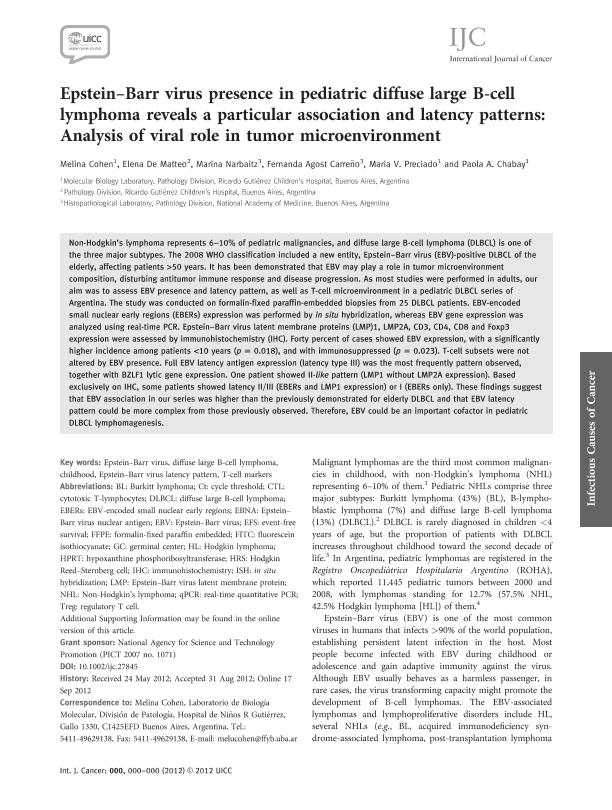Artículo
Epstein–Barr virus presence in pediatric diffuse large B-cell lymphoma reveals a particular association and latency patterns: Analysis of viral role in tumor microenvironment
Cohen, Melina ; de Matteo, Elena Noemí
; de Matteo, Elena Noemí ; Narbaitz, Marina; Agost Carreño, Fernanda; Preciado, María Victoria
; Narbaitz, Marina; Agost Carreño, Fernanda; Preciado, María Victoria ; Chabay, Paola Andrea
; Chabay, Paola Andrea
 ; de Matteo, Elena Noemí
; de Matteo, Elena Noemí ; Narbaitz, Marina; Agost Carreño, Fernanda; Preciado, María Victoria
; Narbaitz, Marina; Agost Carreño, Fernanda; Preciado, María Victoria ; Chabay, Paola Andrea
; Chabay, Paola Andrea
Fecha de publicación:
04/2013
Editorial:
Wiley
Revista:
International Journal of Cancer. Journal International du Cancer
ISSN:
0020-7136
e-ISSN:
1097-0215
Idioma:
Inglés
Tipo de recurso:
Artículo publicado
Clasificación temática:
Resumen
Non-Hodgkin's lymphoma represents 6–10% of pediatric malignancies, and diffuse large B-cell lymphoma (DLBCL) is one of the three major subtypes. The 2008 WHO classification included a new entity, Epstein–Barr virus (EBV)-positive DLBCL of the elderly, affecting patients >50 years. It has been demonstrated that EBV may play a role in tumor microenvironment composition, disturbing antitumor immune response and disease progression. As most studies were performed in adults, our aim was to assess EBV presence and latency pattern, as well as T-cell microenvironment in a pediatric DLBCL series of Argentina. The study was conducted on formalin-fixed paraffin-embedded biopsies from 25 DLBCL patients. EBV-encoded small nuclear early regions (EBERs) expression was performed by in situ hybridization, whereas EBV gene expression was analyzed using real-time PCR. Epstein–Barr virus latent membrane proteins (LMP)1, LMP2A, CD3, CD4, CD8 and Foxp3 expression were assessed by immunohistochemistry (IHC). Forty percent of cases showed EBV expression, with a significantly higher incidence among patients <10 years (p = 0.018), and with immunosuppressed (p = 0.023). T-cell subsets were not altered by EBV presence. Full EBV latency antigen expression (latency type III) was the most frequently pattern observed, together with BZLF1 lytic gene expression. One patient showed II-like pattern (LMP1 without LMP2A expression). Based exclusively on IHC, some patients showed latency II/III (EBERs and LMP1 expression) or I (EBERs only). These findings suggest that EBV association in our series was higher than the previously demonstrated for elderly DLBCL and that EBV latency pattern could be more complex from those previously observed. Therefore, EBV could be an important cofactor in pediatric DLBCL lymphomagenesis.
Archivos asociados
Licencia
Identificadores
Colecciones
Articulos(SEDE CENTRAL)
Articulos de SEDE CENTRAL
Articulos de SEDE CENTRAL
Citación
Cohen, Melina; de Matteo, Elena Noemí; Narbaitz, Marina; Agost Carreño, Fernanda; Preciado, María Victoria; et al.; Epstein–Barr virus presence in pediatric diffuse large B-cell lymphoma reveals a particular association and latency patterns: Analysis of viral role in tumor microenvironment; Wiley; International Journal of Cancer. Journal International du Cancer; 132; 7; 4-2013; 1572-1580
Compartir
Altmétricas



